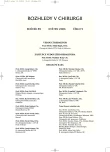Technical Aspects of the Liver Resection Procedure – Options for Combinations of Individual Methods
Authors:
F. Vyhnánek; L. Denemark; V. Ducháč
Authors‘ workplace:
Chirurgická klinika Fakultní nemocnice Královské Vinohrady, Praha, přednosta doc. MUDr. J. Fanta, DrSc.
; Traumatologické centrum Fakultní nemocnice Královské Vinohrady, Praha, vedoucí lékař doc. MUDr. F. Vyhnánek, CSc.
Published in:
Rozhl. Chir., 2006, roč. 85, č. 5, s. 239-243.
Category:
Monothematic special - Original
Overview
Introduction:
The liver resection procedure as a treatment method of benign and malignant hepatobiliary disorders grows more important due to the fact, that its postoperative morbidity and mortality rates have been reduced, a result of the patients selection method, surgical techniques and perioperative care improvements. The aim of this report was to assess combinations of recent liver transsection techniques, based on the authors‘ own experience and results of recent studies.
Material, Methods and Results:
From 1999 to May 2005, in the Surgical Clinic of the Faculty Hospital Královské Vinohrady in Prague, the liver resection procedure was completed in 133 patients with benign or primary and secondary malignant tumors. In the liver transsection procedure, the following instrumentation was used, starting from 1999: harmonic scalpels, ultrasonographic dissectors, water jet scalpel, bipolar diathermia, argon coagulation and radiofrequency. The liver tissue dissection using the ultrasonographic dissector or the water jet scalpel in combination with the harmonic scalpel or bipolar diathemic coagulation, reduced the postoperative blood loss in extensive non-anatomical liver resections. This dissection method was also used in some “centrally“ located tumors for their non-anatomical resections. The benefit of the combination of the methods is based on sufficient coagulation and interruption of minor vascular branches and bile ducts in the resection line, without intermittent closure of the blood influx to the liver, using a Pringle manoeuvre. The radiofrequency, as a novel method for the liver tumors ablation, was used in anatomical and non-anatomical liver resections to coagulate the liver tissue prior to its transection prior to the R0 resection. The postoperative morbidity rate was 14% (19 patients). Within 30 postoperative days, no death was recorded.
Conclusion:
1. The above listed liver transsection techniques, employing the ultrasonographic dissector or water jet scalpel, are safe alternative liver resection methods, reducing the blood loss. 2. Diathermic coagulation is an alternative to the harmonic scalpel for intersecting minor intraparenchymatous vascular branches and bile ducts. 3. A combination of the ultrasonographic dissector technique or water jet scalpel with the harmonic scalpel or diathermic coagulation technique, aids the liver resection by closing and interrupting the vessels and bile ducts in the resection line. 4. Radiofrequency and pre-transsectional coagulation of the liver parenchyma reduces the bleeding during the resection procedure and is a method of choice in resections of centrally located tumors, reducing the loss of the functional parenchyma.
Key words:
liver resection – novel technology – combination of techinques
Labels
Surgery Orthopaedics Trauma surgeryArticle was published in
Perspectives in Surgery

2006 Issue 5
Most read in this issue
- Laparoscopic Rectopexis
- Tracheal Tumor – A Case Review
- Percutaneous Cholecystostomy in Acute Cholecystitis – A Solution for Risk Patient Groups?
- Pancreatectoduodenectomy for Multiple Duodenal Diverticula. Case Report
